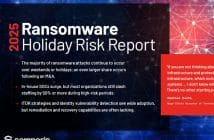
In what is claimed as a world first, three cybersecurity companies Vault Cloud, QuintessenceLabs and Ziroh Labs have announced the integration of homomorphic encryption in a hyperscale cloud.
The project connects commercial quantum solutions with cryptographic applications in a secure cloud. The companies have integrated advanced Australian physics capabilities, with an offering to government and industry coming in late 2019.
Secure cryptographic applications require a large amount of true random numbers. Traditionally, random numbers are generated using algorithms, seeded by observing events inside operating systems and networks. Modern applications need large amounts of entropy and, without a large supply, applications must either slow down or risk lowering their protection.
QuintessenceLabs’ Quantum Random Number Generator (QRNG) generates true random numbers using a phenomenon called quantum tunnelling. Charged particles tunnel through a diode in an unpredictable way, creating random fluctuations that are processed and delivered at 1Gbit/s. The QRNG is available as a standalone solution or integrated into the qCrypt key management capabilities to meet organizations’ entropy and security needs.
QuintessenceLabs’ software integration makes this function available to applications as a service over the network. This can be seamlessly integrated into default and standard endpoints with no changes to client software configurations. “Organisations are subject to an increasing number of cyber-attacks, and traditional approaches are no longer sufficient to securely protect information,” said QuintessenceLabs founder and CEO, Vikram Sharma. “QuintessenceLabs is delighted to bring our quantum cybersecurity capabilities to this unique Australian integration, giving industry and government access to the strongest data protection.”
Vault Cloud’s hyperscale cloud has also integrated its new Barbican technology – a sophisticated key and secrets management layer with access auditing. In an AustCyber funded project, part of its AU$15 million Projects Fund, Barbican was connected to QuintessenceLabs’ qStream, underpinned by their quantum technology, creating the next generation of cloud encryption.
Vault Cloud will offer this new technology to customers later this year. “We are excited to be able to integrate cutting-edge Australian research and resulting deep tech advancement into our secure cloud and give access to this enhanced key and secrets management to governments and critical infrastructure providers,” said Rupert Taylor-Price, founder and CEO of Vault Cloud.
Ziroh Labs’ homomorphic encryption technology allows data to remain encrypted while certain operations are performed on it. This technology was integrated into the identity, secrets management and storage systems of Vault Cloud. Ziroh Lab’s OStor system allows content, metadata, folder structures and content index to be stored in encrypted format while being available for search, viewing and retrieval without decrypting on the server side. This integration work takes another large stride towards delivering homomorphic encryption to end users.
“In addition to OStor, Ziroh Labs has launched developer friendly products for organisations to easily adopt homomorphic encryption without requiring specialised teams to get the benefit,” said Hrishikesh Dewan, Founder and CEO of Ziroh Labs Inc.
Through the combining of several technologies into a new commercialised solution, the AustCyber Projects Fund has supported the development of an advanced, secure, scalable and easily deployable package for an Enterprise File Synchronization and Sharing (EFSS) system leveraging full-entropy quantum keys and homomorphic encryption. This allows an ‘always encrypted’ paradigm, with features like secure cloud storage, search and collaboration on encrypted data.





